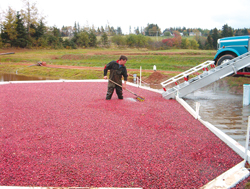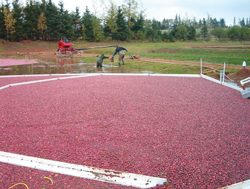
Features
Production
Research
P.E.I. grower advancing cranberry production
April 23, 2008 By Stella Shepard
Mike and Lete Whitty of Prince
Edward Island started growing cranberries four years ago.
 |
| A sea of red cranberries floating on water was harvested mid-October on Prince Edward Island. Fruit farmer, Mike Whitty, of St. Peters Bay, Prince Edward Island corralled the berries onto a conveyor belt. With wet harvesting the cranberry fields are flooded. A beater is run over the vines to shake the berries lose. It does not damage the berries because they land softly in the water. The berries are corralled with wooden booms and then pumped and loaded onto trucks. Photo by Stella Shepard |
 |
Mike and Lete Whitty of Prince Edward Island started growing cranberries four years ago. They planted their first five acres in June of 2000. They planted the other five acres in July 2003. Last year, Whitty harvested 12,000 pounds per acre from his five-acre bed and 60,000 pounds total.
“Cranberries grow naturally on Prince Edward Island so we decided, since only a few people on Prince Edward Island were growing the fruit, we would,” Mike said. “More people are now interested in growing cranberries that are well-known for its high vitamin C content. Today, on Prince Edward Island there are about
16 Island cranberry producers.”
Cranberry production is a slow growing industry on Prince Edward Island with only 75 acres of cranberries planted. However, about one-half is in production; about 35 to 40 acres. Last year, 300,000 pounds of cranberries were harvested on Prince Edward Island. Mike and Lete, of St. Peters Bay, said 75 acres might be pale in comparison to other fruits produced on Prince Edward Island. But 75 acres of commercially produced cranberries is considered a high volume for Prince Edward Island. But for other parts of Canada and the United States, cranberries are a hot growing commodity driving the price of the fruit down. Last year the market price was 60 cents a pound. Island cranberry producers are uncertain of this year’s market price.
“The price has been down for the last two years, and, I expect it to be low again this year,” Mike said. “There are no local processors on the Island. Our berries are trucked to the United States and Quebec. We also sell at the farm gate and at the farmers’ market in Charlottetown.”
Mike and Lete, who are members of the P.E.I. Cranberry Growers Assoc-iation, said the 13 members meet regularly. Robert Walsh, of Savage Harbour, is the president of the P.E.I. Cranberry Growers’ Association. He said people are reluctant to become involved in the industry because of the cost involved. It takes a commitment of time and money to establish cranberry bogs that require an ongoing water supply.
To start a cranberry bog, all wild growth must be removed. The land has to be leveled before vines are planted. It takes two to three years before the vine will produce fruit and five to six years of careful management before the vines will be full-bearing. A high level of bee activity is important to pollinate the crop. It’s not unusual for a cranberry bog to be still in production after 80 to 100 years. Farmers are challenged with late frost in June that can damage plants. To protect from frost damage, growers spray the crops with water as temperature nears freezing. The water forms a layer of ice on the berry and the heat within the berry protects the fruit from freezing.
Mike, who owns his own construction company, was able to cut costs by using his own equipment to construct the cranberry bogs. He also constructed a reservoir next to the cranberry bogs. Two electrical pumps funnel water from the reservoir through underground irrigation lines to the adjacent cranberry bogs.
“The cranberry bogs have to be perfectly leveled with water,” Mike said. “We harvest the cranberry bogs with 10 to 12 inches of water pumped in from the adjacent reservoir.”
The fruit farmers are not in the industry just for the market price of the cranberries. Lete and Mike said it’s satisfying and self-rewarding to harvest a crop. They invest time, labour and money into cranberry production, simply for the “love of doing it.” Every fall harvest, Lete and Mike host an open farm day. People island-wide travel to the cranberry bogs to observe the harvesting and the opportunity to purchase the fruit just in time for the Thanksgiving holiday. The sales are higher during the Thanksgiving holiday, Lete noted, because of the popularity of cranberries on the festive dinner table.
“It is beautiful sight to watch a red sea of cranberries floating on water,” Mike said. “It makes the long hours and hard work worth it all. Harvesting the cranberries is also a social gathering. We invite friends and family to help out with the harvest.”
Print this page